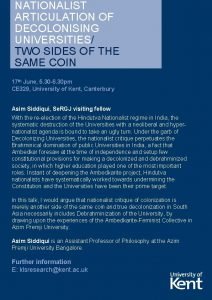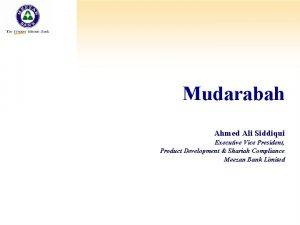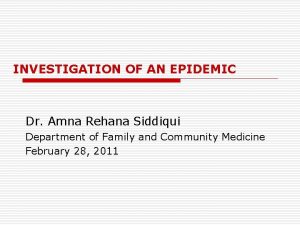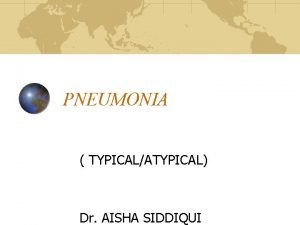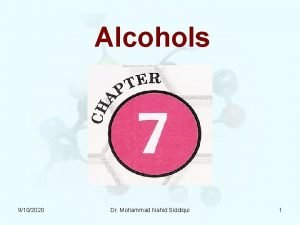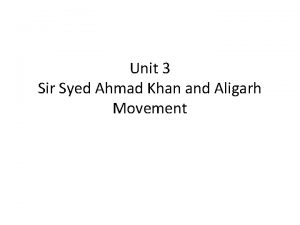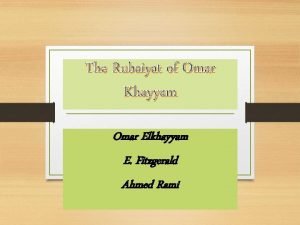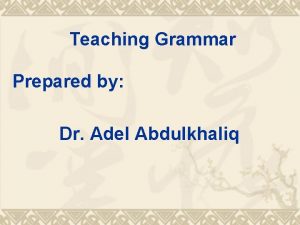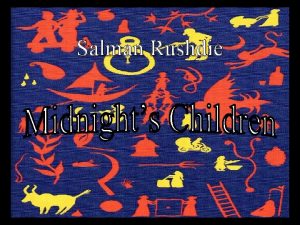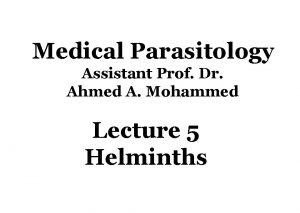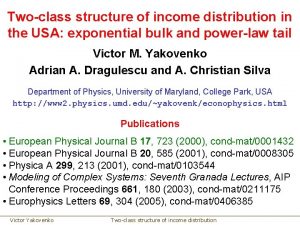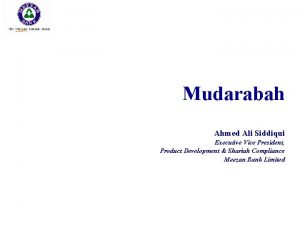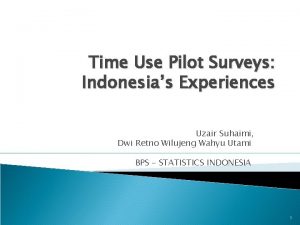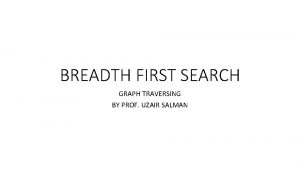TwoClass Weather Classification UZAIR AHMED SIDDIQUI 18296 TwoClass

































- Slides: 33

Two-Class Weather Classification UZAIR AHMED SIDDIQUI - 18296

Two-Class Weather Classification https: //www. cv-foundation. org/openaccess/content_cvpr_2014/papers/Lu_Two-Class_Weather_Classification_2014_CVPR_paper. pdf Cewu Lu, Di Lin, Jiaya Jia, Chi-Keung Tang The Hong Kong University of Science and Technology The Chinese University of Hong Kong Presented in: The IEEE Conference on Computer Vision and Pattern Recognition (CVPR), 2014, Project link: http: //www. cse. cuhk. edu. hk/leojia/projects/weatherclassify/

Two-Class Weather Classification Target: Using a single outdoor image, label it as either sunny or cloudy

Two-Class Weather Classification Previous work Classification using structural information based on illumination-invariant features such as SIFT or HOG lack of weather prior

Two-Class Weather Classification surveillance cameras utilizing cameras from autonomous vehicles around the globe robotic vision

Approach Identify weather cues such as sky, shadow, reflection, contrast and haze form the weather feature classify

Approach Issue: not all of the weather cues are available in an image Solution a collaborative learning framework using homogeneous voters group outdoor images into clusters Clusters based on weather cues Weighted vote of clusters classifier outputs

Weather Feature Cues Sky Shadow Reflection Contrast Haze

Weather Feature Cues Sky Shadow Reflection Contrast Haze Vector for contrast is always 1 621 -D feature vector

Weather Feature - SKY 20, 000 15 x 15 patches 131 dimensional feature Random forest classifier learned

Weather Feature - SKY F- sk vector: Color histogram can be used Calculated using color-pair dictionary coding

Weather Feature - SKY F- sk vector: Collected 2000 images Neighborhood pixels in pairs are extracted -> 6 D vectors with 6 RGB values -> 100 K pixel pairs C. Lu, J. Shi, and J. Jia. Online robust dictionary learning. In CVPR, 2013

Weather Feature - SHADOW Misclassification of dark regions Both vectors calculated using shadow detection tools J. -F. Lalonde, A. Efros, and S. Narasimhan. Detecting ground shadows in outdoor consumer photographs. In ECCV, 2010

Weather Feature - SHADOW Shadow boundries detected with confidence scores and boundries Top 10 confident boundries are moved to pool P 10 V samples (V is no of training sunny images) Measure likelihood of boundary in given image using the mean distance to its k=5 nearest neighbors in P J. -F. Lalonde, A. Efros, and S. Narasimhan. Detecting ground shadows in outdoor consumer photographs. In ECCV, 2010

Weather Feature - REFLECTION a brightly lit region in the image where pixels in the region center are brightest and saturated in nearly all color channels intensity decays from the center toward the boundary J. -F. Lalonde, A. Efros, and S. Narasimhan. Detecting ground shadows in outdoor consumer photographs. In ECCV, 2010

Weather Feature - REFLECTION V-re is 1 if white pixels are present in the image and 0 otherwise For F-re, apply image matting at the detected white pixels Given the matting result (b) and (f) plot the alpha matte distributions as shown in (d) and (h), and then assign the 100 -bin alpha matte histogram as our 100 -D F-re vector J. -F. Lalonde, A. Efros, and S. Narasimhan. Detecting ground shadows in outdoor consumer photographs. In ECCV, 2010

Weather Feature - CONTRAST contrast information encoded as image saturation percentile a value at the 20 th saturation percentile means that 20% of the image pixels are grayer than it if all saturation percentiles are the same for a given image, the saturation contrast is low. High difference in immediate percentiles mean image is very likely to have a high saturation contrast

Weather Feature - CONTRAST contrast information encoded as image saturation percentile a value at the 20 th saturation percentile means that 20% of the image pixels are grayer than it if all saturation percentiles are the same for a given image, the saturation contrast is low. High difference in immediate percentiles mean image is very likely to have a high saturation contrast 171 percentile ratios are obtained to make a 171 -D F-co

Weather Feature - HAZE Dark channel is computed Jc is a color channel and Ω(x) is a local patch (with 8 × 8) centered at x. Existence vector is the median value of the dark channel of the image K. He, J. Sun, and X. Tang. Single image haze removal using dark channel prior. In CVPR, 2009

Weather Feature - HAZE For F-ha image is resized into 512 × 512 dark channel in each image is uniformly partitioned into 22, 42, and 82 non-overlapping regions use the median value of dark channel intensities in these regions to form the 84 -D F-ha vector K. He, J. Sun, and X. Tang. Single image haze removal using dark channel prior. In CVPR, 2009

Voting Traditional classifiers such as SVM cannot achieve good performance on our weather feature because they assume all components to present simultaneously in all images Partition training images into disjoint clusters of homogeneous voters Given a test image, voters closer to it are given more weights for correctly finding the weather label

Voting Training images are first partitioned into homogeneous clusters according to the existence vector The partitioned sets thus correspond to different weather cue patterns, such as “reflection + shadow”, “sky + haze”, and “sky + reflection + shadow” Images belonging to the same cluster/pattern are said to be homogeneous

Voting we partition the set of training images into M subsets {Ω 1, . . . , ΩM} cluster error threshold is 0. 5 in terms of Euclidean distance M can be found automatically. We denote the set of cluster center vectors as {e 1, . . . , e. M}

Voting given a weather feature x with existence vector e, rely on training data whose existence vectors are similar to e , the classifier is where sign[·] is the function outputting 1 (resp. − 1) for non-negative (resp. negative) input, is a similarity function under parameter σ: The classifier gives a larger weight to the homogeneous voter whose existence vector pattern is similar to that of the testing data.


Collaborative Learning Experiments ◦ 10 K final images for training and testing. The dataset and our executable that implements the above collaborative learning will be made publicly available ◦ collected 14, 000 outdoor images in which sunny and cloudy images are roughly 50% each ◦ Rejecting identical images ◦ compute the color histogram distance for all image pairs, and manually reject those, which are identical or highly similar. ◦ Images labeled as ambiguous weather condition by either or both of them are discarded

Classification in each round, 80% of the data are selected randomly as the training set, with the remaining 20% belong to the testing set. 5 rounds are performed to report the mean and variance of the classification accuracy. On two-class labeling, even random guess can reach 50% accuracy. We normalize accuracy for better expressing the results. It is expressed as max{(a − 0. 5)/(1 − 0. 5), 0}, where a is the accuracy obtained traditionally. This normalized accuracy ranges in [0, 1] and random guess generally gets zero.

Classification sky is the most important weather cue among the five. The majority of failure cases are images without a prominent sky region reflection and shadow classifiers also work well.

Classification For each weather cue, we select s percent images with the highest existence score in the dataset and apply SVM classification on this image subset The plot indicates that our existence score design is effective – a weather cue gets more useful with a higher existence score

Results

Results

Comparison

Thank you Paper Link: https: //www. cv-foundation. org/openaccess/content_cvpr_2014/papers/Lu_Two. Class_Weather_Classification_2014_CVPR_paper. pdf Executable and Weather dataset: http: //www. cse. cuhk. edu. hk/leojia/projects/weatherclassify/
 Shirkat ul mufawada
Shirkat ul mufawada Uzair bhatti
Uzair bhatti Ahmed muhudiin ahmed
Ahmed muhudiin ahmed Durre siddiqui
Durre siddiqui Bashir siddiqui
Bashir siddiqui Asim siddiqui azim premji university
Asim siddiqui azim premji university Nahid siddiqui
Nahid siddiqui Mahvash siddiqui
Mahvash siddiqui Ali siddiqui
Ali siddiqui Dr rehana siddiqui
Dr rehana siddiqui Mrs. najma dowla
Mrs. najma dowla Dr aisha siddiqui
Dr aisha siddiqui Areej aftab siddiqui
Areej aftab siddiqui Gazala siddiqui md
Gazala siddiqui md Dr ahmad faisal
Dr ahmad faisal Dr nahid siddiqui
Dr nahid siddiqui Sameera siddiqui
Sameera siddiqui Dr siddiqui thousand oaks
Dr siddiqui thousand oaks Amna siddiqui
Amna siddiqui Weather symbols station model
Weather symbols station model Whether the weather be fine
Whether the weather be fine Poem of seasons
Poem of seasons Noun of windy
Noun of windy Whether the weather be fine
Whether the weather be fine Heavy weather by weather report
Heavy weather by weather report Capital weather gang weather wall
Capital weather gang weather wall Political services of sir syed ahmad khan
Political services of sir syed ahmad khan Ahmed rami poems
Ahmed rami poems Adel ahmed alalla
Adel ahmed alalla United indian patriotic association in hindi
United indian patriotic association in hindi Ahmed salman rushdie
Ahmed salman rushdie Ahmed salemi
Ahmed salemi Salyanesiz eyalet nedir
Salyanesiz eyalet nedir Dr mohammed ahmed
Dr mohammed ahmed





